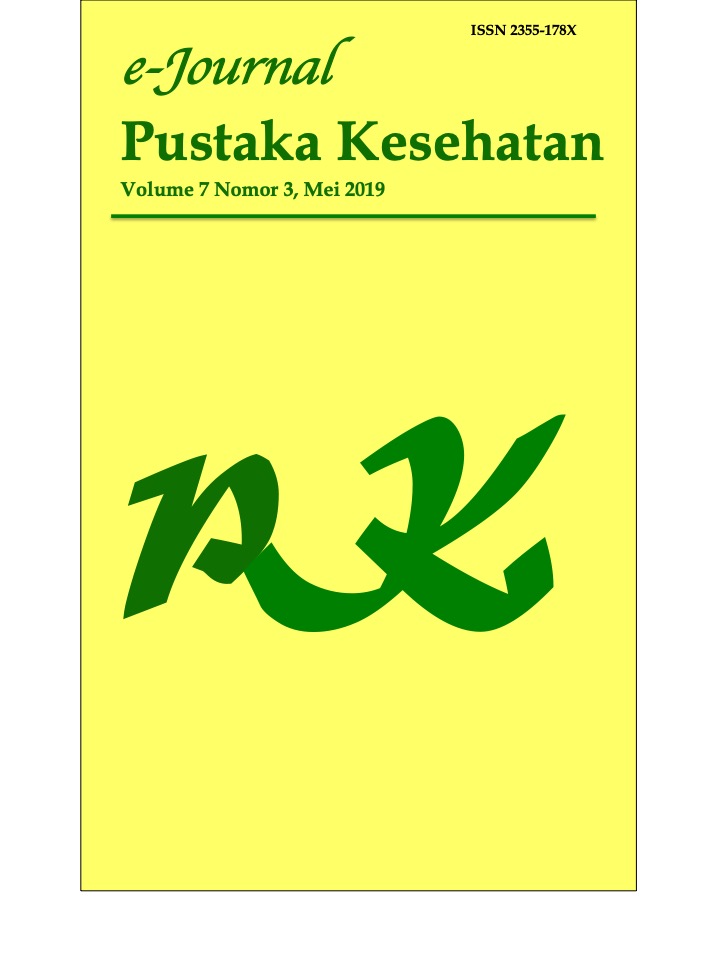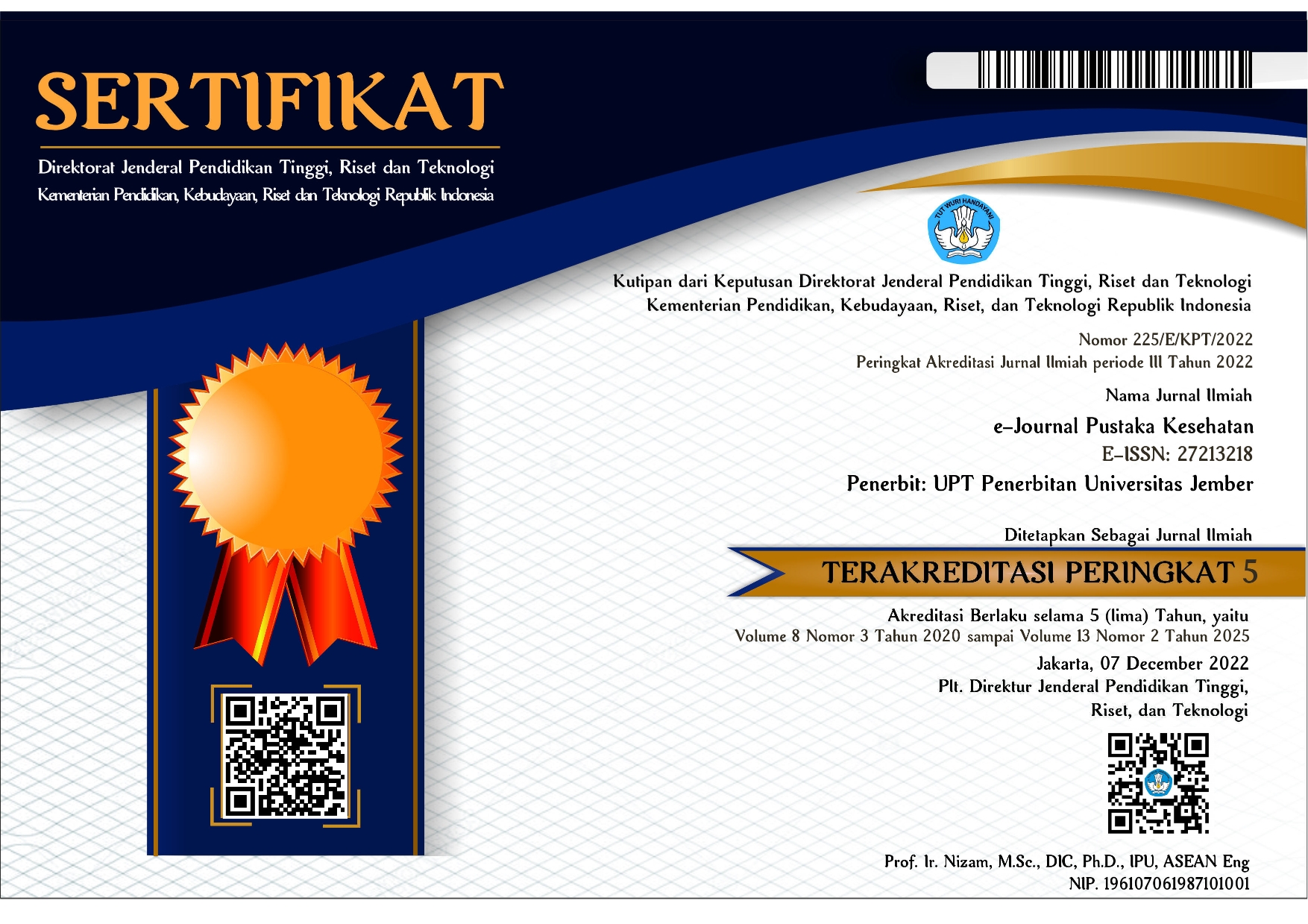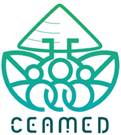Gambaran Perkembangan Motorik Kasar pada Balita Usia 1-3 Tahun dengan Stunting di Wilayah Kerja Puskesmas Sumberjambe, Jember
DOI:
https://doi.org/10.19184/pk.v7i3.10942Keywords:
Gross Motor Development, Toddler, StuntingAbstract
The condition of stunting toddlers can affect the ability in aspects of gross motor development. Gross motor development of stunting toddlers is also influenced by optimal nutritional status between the balance of intake and nutritional needs. This study aims to determine the description of gross motor development in stunted infants aged 1-3 years (toddler) in Sumberjambe Health Center, Jember Regency. This study used a descriptive design with a cross sectional approach. Respondents within this study were 200 stunted toddlers with purposive sampling method. The data collection was carried out using the Denver II observation sheet. Data analysis was performed by descriptive analysis by describing data in table form. The results of gross motor development found that 144 infants (72,0%) had normal gross motor development, 43 toddlers (21,5%) had suspected, and 13 toddlers (6,5%) had abnormal gross motor development. The role of parents, family, and the environment is expected to be able to be involved and directly control the condition of toddlers by frequently interacting to determine motor skills in achieving gross motoric development that is optimal in stunted toddlers.
Downloads
References
[2] Kementerian Kesehatan Republik Indonesia. Buku saku pemantauan status gizi tahun 2017. Jakarta: Direktorat Gizi Masyarakat; 2017.
[3] Dinas Kesehatan Provinsi Jawa Timur. Data stunting di Kabupaten Jember tahun 2018. Jawa Timur: Bidang Kesehatan Masyarakat; 2018.
[4] Supariasa, I. D. N., B. Bakri, & I. Fajar. Penilaian status gizi. Jakarta: EGC; 2002.
[5] World Health Organization (WHO). Childhood stunting: challenges and opportunities. Report of a webcast colloquium on the operational issues around setting and implementing national stunting reduction agendas. [Internet]. Geneva: World Health Organization; 2014 [cited 20 Oktober 2018]. Available from: https://apps.who.int/iris/bitstream/handle/10665/107026/WHO_NMH_NHD_GRS_14.1_eng.pdf;jsessionid=1B500C3A826B275D15CD92A573C60B1A?sequence=1
[6] Wong, D. L. Buku ajar keperawatan pediatrik volume 1. Jakarta: EGC; 2008.
[7] Rusilanti, M. Dahlia, & Y. Yulianti. Gizi dan kesehatan anak prasekolah edisi 1. Bandung: PT Remaja Rosdakarya; 2015.
[8] Soetjiningsih. Tumbuh kembang anak. edisi 2. Jakarta: EGC; 2013.
[9] Kumar, G., M. Kaur, A. M. Rehman, H. Arora, M. M. Rajput, R. Chugh, A. Kurpad, H. S. Sachdev, & S. Filteau. Effects of vitamin D supplementation in infancy on growth, bone parameters, body composition and gross motor development at age 3-6 years: follow-up of a randomized controlled trial. International Journal of Epidemiology. [Internet]. 2015 [cited 12 Oktober 2018]; 44(3): [pp. 894–905]. Available from: https://www.ncbi.nlm.nih.gov/pubmed/26130740
[10] Olney, D. K., E. Pollitt, P. K. Kariger, S. S. Khalfan, N. S. Ali, J. M. Tielsch, S. Sazawal, R. Black, D. Mast, L. H. Allen, & R. J. Stoltzfus. Young zanzibari children with iron deficiency, iron deficiency anemia, stunting, or malaria have lower motor activity scores and spend less time in locomotion. The Journal of Nutrition. 2007 [cited 13 Oktober 2018]; 137(12): [pp. 2756–2762]. Available from: https://www.ncbi.nlm.nih.gov/pubmed/18029495
[11] United Nation Children’s Fund (UNICEF). Improving child nutrition - the achievable imperative for global progress. [Internet]. New York: United Nation Children’s Fund; 2013. [cited 6 Maret 2019]. Available from: https://www.unicef.org/nutrition/index_68661.html
[12] Mugianti, S., A. Mulyadi, A. K. Anam, & Z. L. Najah. Faktor penyebab anak stunting usia 25-60 bulan di kecamatan sukorejo kota blitar. Jurnal Ners dan Kebidanan [Internet]. 2018 [cited 22 April 2019]; 5(3): [pp.268–278]. Available from: jnk.phb.ac.id/index.php/jnk/article/download/374/pdf
[13] Ulfah, E., S. E. Rahayuningsih, H. Herman, H. Susiarno, D. A. Gurnida, U. Gamayani, & H. Sukandar. Asuhan nutrisi dan stimulasi dengan status pertumbuhan dan perkembangan balita usia 12 – 36 bulan. Global Medical and Health Communication [Intenet]. 2018 [cited 14 Februari 2019]; 6(38):[pp. 12–20]. Available from: https://ejournal.unisba.ac.id/index.php/gmhc/article/download/2323/pdf
[14] Adriani, M. & B. Wirjatmadi. Gizi dan kesehatan balita. Jakarta: Kencana Prenadamedia Group; 2014.
[15] Syahputri, S. R. Gambaran perkembangan pada balita stunting di desa wunung wilayah kerja puskesmas wonosari I gunungkidul yogyakarta. Skripsi. Yogyakarta: Sekolah Tinggi Ilmu Kesehatan Jenderal Achmad Yani; 2017.
[16] Fikawati, S., A. Syafiq, & A. Veratamala. Gizi anak dan remaja edisi 1. Depok: PT Raja Grafindo Persada; 2017.
[17] Pulungan, D. S. Status sosial ekonomi keluarga dan pola konsumsi makan anak stunting dan normal di sdn 157528 naispospos barat 2 kecamatan sorkam kabupaten tapanuli tengah. [Intenet] 2015 [cited 23 April 2019]; 6(2):[pp.103]. Available from: https://jurnal.usu.ac.id/index.php/gkre/article/view/17080
[18] Febrikaharisma, M. H. Hubungan Antara TB / U dengan Fungsi Motorik Anak Usia 2-4 Tahun. Skripsi. Semarang: Fakultas Kedokteran Universitas Diponegoro; 2013.
[19] Herlina, T., Subagyo, & R. Agustin. Perbedaan perkembangan anak usia 4-5 tahun antara yang ikut paud dan tidak ikut paud. Jurnal Kesehatan Forikes; 2010.
[20] Poborini, A., Maulidha, & D. Larasati. Faktor-faktor yang mempengaruhi keterlambatan perkembangan anak usia 1-3 tahun di desa cangkringsari kecamatan sukodono kabupaten sidoarjo. Journal of Issues in Midwifery [Internet] 2017 [cited 25 April 2019]; 1(1): [pp.1–18]. Available from: http://bidan.fk.ub.ac.id/wpcontent/uploads/2013/08/1.6
[21] Hanani, R. & A. Syauqy. Perbedaan perkembangan motorik kasar, motorik halus, bahasa, dan personal sosial pada anak stunting dan non stunting. Nutrition College [Internet]. 2016 [cited 8 April 2019]; 5(4):[pp.412–418]. Available from:https://ejournal3.undip.ac.id/index.php/jnc/article/view/16452
[22] Suharyanto, E. R., T. P. Hastuti, & H. Triredjeki. Hubungan status gizi dengan perkembangan anak usia 1 sampai 5 tahun di kelurahan tidar utara kota magelang. Jurnal Keperawatan Soedirman [Internet}. 2017 [cited 15 April 2019]; 12(1):[pp.27]. Available from:http://jks.fikes.unsoed.ac.id/index.php/jks/article/view/686.
Downloads
Published
Issue
Section
License
e-Journal Pustaka Kesehatan has CC-BY-SA or an equivalent license as the optimal license for the publication, distribution, use, and reuse of scholarly work. Authors who publish with this journal retain copyright and grant the journal right of first publication with the work simultaneously licensed under a Creative Commons Attribution-ShareAlike 4.0 International License that allows others to share the work with an acknowledgment of the work's authorship and initial publication in this journal.







